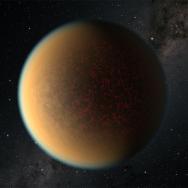Known for beaming stunning images back to Earth, NASA’s James Webb Space Telescope just scored another first: an incredibly detailed chemical portrait of a distant world’s skies—including what its clouds look like.
The telescope’s array of highly sensitive instruments was trained on the atmosphere of a planet orbiting a star some 700 light-years away – known as WASP-39 b.
While we already had isolated ingredients of this broiling-hot planet’s atmosphere, the new readings provide a full menu of atoms, molecules, and even signs of active chemistry and clouds. The latest data also give a hint of how these clouds might look up close: broken up rather than a single, uniform blanket over the planet.
The suite of discoveries is detailed in a set of five new scientific papers submitted for publication.
“Data like these are a game changer,” said Natalie Batalha, an astronomer at the University of California, Santa Cruz, who contributed to and helped coordinate the new research.
A band of patchy clouds
WASP-39b is about as massive as Saturn. Like Saturn, it is a gas giant, but it sits much closer to its star—making it much hotter. It is also likely a “tidally locked” planet, meaning that one side of the planet is perpetually in nighttime and the other side perpetually in the daytime.
At the band where the day and night side meet, one of the new studies reveals, there are scattered clouds—so that perhaps 60 to 70% of the sky is covered. The patchiness is interesting to scientists as they try to put together an understanding of how clouds on other planets might behave.
"We don’t understand the physics of clouds on other planets, but we know that they are a common phenomenon."
“We don’t understand the physics of clouds on other planets, but we know that they are a common phenomenon,” said Adina Feinstein, a University of Chicago graduate student and first author of the paper. “These findings give us constraints that we can use to determine the composition and typical size of the cloud particles.”
Among the other unprecedented revelations is the first detection in an exoplanet atmosphere of sulfur dioxide. Scientists are particularly excited about this molecule because it is produced from chemical reactions triggered by high-energy light from the planet’s parent star—on Earth, the protective ozone layer in the upper atmosphere is created in a similar way—and this is the first concrete evidence of this process on exoplanets.
“Planets are sculpted and transformed by orbiting within the radiation bath of the host star,” Batalha said. “On Earth, those transformations allow life to thrive.”
At an estimated temperature of 1,600 degrees Fahrenheit (900 degrees Celsius) and an atmosphere made mostly of hydrogen, WASP-39 b is not believed to be habitable. But the new work points the way to finding evidence of potential life on a habitable planet.
Other atmospheric constituents detected by the JWST telescope include sodium, potassium, and water vapor, confirming previous space and ground-based telescope observations as well as finding additional water features, at longer wavelengths, that haven’t been seen before.
Feinstein is particularly interested in the potassium measurements, which could provide clues to how WASP-39 b formed.
She explained that from the relative amounts of different elements, they can tell that WASP-39 b most likely would have formed farther away from its star. “This tells you about the planet formation process,” she said. “The observations suggest that this planet could have formed very far away from the star, and its current position, and collided with rocks rich in other elements, like potassium, as it moved inward.”
‘A scientific tour de force’
To see light from WASP-39 b, JWST tracked the planet as it passed in front of its star, allowing some of the star’s light to filter through the planet’s atmosphere. Different types of chemicals in the atmosphere absorb different colors of the starlight spectrum, so the colors that are missing tell astronomers which molecules are present.

Capturing such a broad spectrum of WASP-39 b’s atmosphere was a scientific tour de force, as an international team numbering in the hundreds independently analyzed data from four of the JWST telescope’s finely calibrated instrument modes.
Scientists among the first to see the spectrum data said it was nothing short of breathtaking. “I am not going to lie: When I first saw the data, I cried,” said Hannah Wakeford, an astrophysicist at the University of Bristol in the United Kingdom who investigates exoplanet atmospheres.
Jacob Bean, a University of Chicago professor of astronomy and astrophysics who co-leads the large international team analyzing all of JWST’s exoplanet results, said in the next months and years scientists will dig further and further into the data beyond this initial analysis.
“We’ll try to understand what it all means,” he said. “We’ll put it together with observations of other planets and see what we can say about what the landscapes look like for these kinds of planets and how we can use JWST in the future.”
But it’s already clear that JWST telescope’s instruments performed well beyond scientists’ expectations – even finding surprises on planets we had already studied previously – and that the telescope promises a new phase of exploration among the broad variety of exoplanets in the galaxy.
Citation: “JWST Early Release Science: Exoplanet transit spectroscopy with NIRISS-SOSS.” Feinstein et al.
Funding: NASA, National Science Foundation, National Sciences and Engineering Research Council of Canada, Fonds de Recherche du Quebec, Institut de Recherche sur les Exoplanetes.








